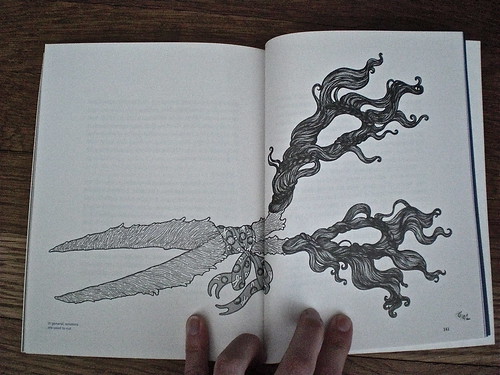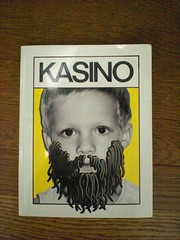. The interview, conducted by
(Bruno Colajanni) was published today and though it's in Italian, it is still a beautiful site to just look around on.
Yes, we remember that day very well! It wasn't the first time we met, we had known each other through mutual friends for a few years at that time, but it was the first time we ever really talked. We went on a camping trip with a group of friends to Okutama, a beautiful mountainous area with deep, narrow ravines, not far from Tokyo. After dinner we found ourselves together and began talking about our interests and found our ideas and thoughts to be amazingly aligned. Everyone was gathering in a cabin but we went to an empty one and began drawing together. Talking and drawing we stayed up all night and knew that we had to continue together, something had been sparked.
3. Do you share a desk or do each of you have your own desk? Can you describe it?
Our main workspace at the moment is a long counter made of plywood and sawhorses where we have our computers and lightboards lined up. We recently moved to a cozy second floor studio/apartment overlooking a river and dam, just a kilometer from the camping spot where we thought up the animation we are currently working on. The river carries the inspiration to us! We have high ceilings and many books in our apartment, most of them belonging to the owner of the house. Plus we have a small room for painting and other messy activities. We used to work facing each other but this new setup seems to be working well!
4. Overture is an "Opera House" where you both sometimes let other people take part in your projects as well. Can you describe how a day goes by for Overture?
We may be picking up help in the near future but for the most part it is just the two of us working on projects! Even when we are working on something like an animation, the musicians involved usually don't live anywhere near us and we typically only communicate through email. In fact most of our work is like that, we really don't do much locally where we live so everything is through the internet - at least during the creation process. We were fortunate to tour Japan this Summer, doing small performances and holding a number of exhibitions and during this time we were able to actually interact with other artists and musicians in person and that was really great and a pretty fresh experience for us!
5. Can you tell me about your studies and experiences in your countries? (I guess Aya comes from Japan). When did you decide to become artists?
A: Yes, I am from Japan! I didn't go to art school but I was an artist's assistant for a while. I've just always drawn, since I was a child.
I think I decided to become an artist when I was with a real artist, working as an assistant or participating in a project.
J: I also didn't go to art school but have always just been making things. I did puppet shows when I was little and wrote stories. I don't think I've ever had a moment where I thought I wanted to be an artist, just a never ending drive to create.
6. In another world what would Jason Malcom and Aya eventually be?
A: I think I would be an animal that could do little detailed things, like a raccoon or squirrel.
J: a taveler on the Silk Road.
7. It seems music plays an important role on Your creation. Does Aya or Jason play music too?
A: We both play a bit of music, though less recently than a year or so ago.
J: I grew up playing a few instruments and singing in school through highschool. When I came to Japan I played in a number of bands and when we moved to the U.S. the two of us would meet with local friends and play music almost once a week. Especially when we are working on an animation, music is an excellent exploration tool and can be a freeing, spiritual release.
8.You did wonderful videos for indie musicians such Haushka, KiraKira and Mùm. Are there other artists you would like to work for too?
Yes, there are many artists we would like to work with! We are constantly looking to expand what kind of music we work with, looking to possibly do more rhythmically oriented pieces or possibly some kind of noise-related animation - although it really depends on what we come upon and who we meet and what the moment holds.
We are also interested in doing more performance based animation and would love to work with people like Cirque du Soleil or Royal de Luxe.
We would also like to work with live film directors for creating short pieces in films or possibly opening/closing animations. Although we are also looking to create our own feature length films in the future - animation and possibly live action as well.
9. First time I saw your creations I found your style unique and in the same time very related to Japan and North Europe imaginary. Maybe because when I was a child I used to watch cartoons as "Tanoshii Moomin Ikka" (from the lovely swedish comics series Moomin by Tove Jansson) or "Tongari Boushi no Memoru", both of them with the character design by Yasuhiro Nakura for Key Animation. Can You tell us in which way the the place where you have lived influenced your imaginary?
A: I'm not sure how much influence it had on my style, but I was born in Beppu, a city famous for its onsen (hot springs) and this certainly has been a big influence on my creations. I read a lot of books, both Japanese and foreign, as a child and over time this has become nutrition for my style.
J: I grew up in the area we live in now, spending a lot of time in the winding woods around my house and also sometimes visiting the labyrinthine hydroelectric stations my father worked at. I spent a lot of time playing by myself.
10. What about your favorite artists?
There are so many great artists who we love and who have influenced our work! We typically find ourselves drawn more to artist writers and folks with stories and ideas than visual artists, but here is a mix of some of our favorites:
Jan Svankmejer, Susan Pitt, Rene Laloux, Friedensreich Hundertwasser, Tezuka Osamu, Michael Ende, Tove Jansson
11. If you could do a remake of a movie, fairytale, book, which ones would You choose?
Hmmm...we would definitely like to do an animated version of Michael Ende's Momo... we would also like to do some simpler fairytale stories, like the Billy Goats Gruff, and possibly something a bit more heavy and recent, like Nakagami Kenji's, The Immortal.
12. On "Bless", the video for the icelandic musician "Kirakira", there are a lot elements about religion, nature, fate and destiny. On the end you can see the Parcae (the Fates), that in Greek mythology were Cloto (the Youth), Làchesi (the Fertility) and Atropo (the Oldness), that can decide when it's time for you to die. Each time I see your animations I feel a deep feeling about nature, religion and mystery as something we should not be scared of. Can animation be a sort of antidote against sadness?
Certainly! Although, we don't necessarily intend anything in the creation of the animation. We do think up the stories and characters and guide the narrative, but we also try to let ideas and themes arise from our unconscious - this was especially true in Bless. Our animation reflects in many ways our lives at the time of creation, our thoughts, outlooks, activities.
13. What made you scared when you were a child? To be alone in the dark? What was your antidote?
A: I was frightened by the expanse of universe and time, especially the idea of existing in the vast space after death. I didn't have an antidote, although these feelings have dulled as I've gotten older.
J: I was afraid of the void and dangerous potential in the shadows. I have had night terrors (sleep paralysis/ kanashibari) since I was little and often thought I was being attacked or punished with electricity by monsters or the Christian God. I had a theory that whenever I thought of nice things before I fell asleep I would have bad dreams so I would force myself to consider scary thoughts in the dark of my room to hopefully have a reverse effect.
14. The style of Overture is special also because that beautiful watercolor texture You use. It's hand made or do You use special software for that?
All the watercolor technique you see in the videos are done by hand. Figuring out how to do that on a computer is a bit over our heads.
15. How long does it take to realize a video such as " Rhubarbidoo"?
Rhubarbidoo was our first kind of music video and we were still figuring out a process. I think we spent the early part of the Summer '07 on it. Generally though we plan animations to go one month for one minute. This changes depending on the type of animation, the amount of time we have to devote to the animation, and other factors.
16. What's the hardest side of your job?
Well, we only work on projects we feel match our own goals and this usually means there isn't much money involved. Having to live off very little or having to work for some kind of supplementary income is extremely taxing and drains a lot of energy we could be focusing on our work. In a similar sense marketing our work is also a side that is very trying for us.
And then balancing a normal life, eating, exercising, spending time with friends, etc. while also spending every free moment on a project is nearly impossible and really wears on our minds and emotions.
Making things, while some aspects are monotonous or difficult to get into, etc. is really a joy compared to these other elements. And while we sometimes butt heads over certain details, working together is one of the driving factors of our artwork and we love this as well.
17. What about your next projects? Will it be possible in the future to see your video and drawings all together on a book?
We have a number of projects we are currently working on and also planning on for the future! We are currently working on a new short animation, the reason for our current location (for research and inspiration), which we are hoping to wrap up by the Spring.
We are also putting together a dance/music/animation performance with KiraKira, while starting work on some book ideas using the water and ink technique we have been honing for the past while.
And then there is a feature length animation we have slowly been planning over the past few years and are currently hunting for funding while fine tuning its proposal package.
We are always looking to work on new animation projects and also want to get more involved in books. We will have a small artbook/zine released from a record label in Japan and we will see where that goes - but we would love to also put together a book collecting stills from our animations and various illustrations! We are also considering a DVD animation collection.






